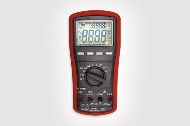• Current (A)
• Voltage (V)
• Resistance (Ω)
• Frequency (Hz)
• Capacitance (F) Farads
• Temperature (°C or K)
• Continuity (buzzing sound)
• Digital multimeter (DMM)
• Clamp meter
• Analogue multimeter
• Insulation tester
• Voltage tester
• Phase rotation
• Earth resistance
• Earth leakage circuit breaker (ELCB) /Polarity
• Loop impedance tester
Measuring instruments need to adhere to international safety standard. Underwriters Laboratories (UL), based in Canada are independent testing laboratory that tests products against international standards.
International measurement categories:
| Category | Level | Description | Example |
| IV | Primary supply level | Meausurement performed at the source of the low voltage installation |
|
| III | Distribution level | Measurement performed at building installation |
|
| II | Local level | Measurement on circuits directly connected to the low voltage installation |
|
| I | Signal level | Measurement of electronic equipment |
|
Multimeters are available as either a digital (DMM) or analogue meter.
This type of meter gives the output reading in numbers and is used to measure:
Other features may include:
Multimeters can be either auto or manual ranging
|
Auto Range |
The range to be measured is automatically selected by the unit manual ranging |
|
|
Manual Range |
The range selected manually using the selector switch prior to the measurement being taken |
 |
|
 |